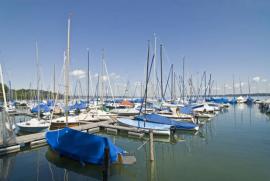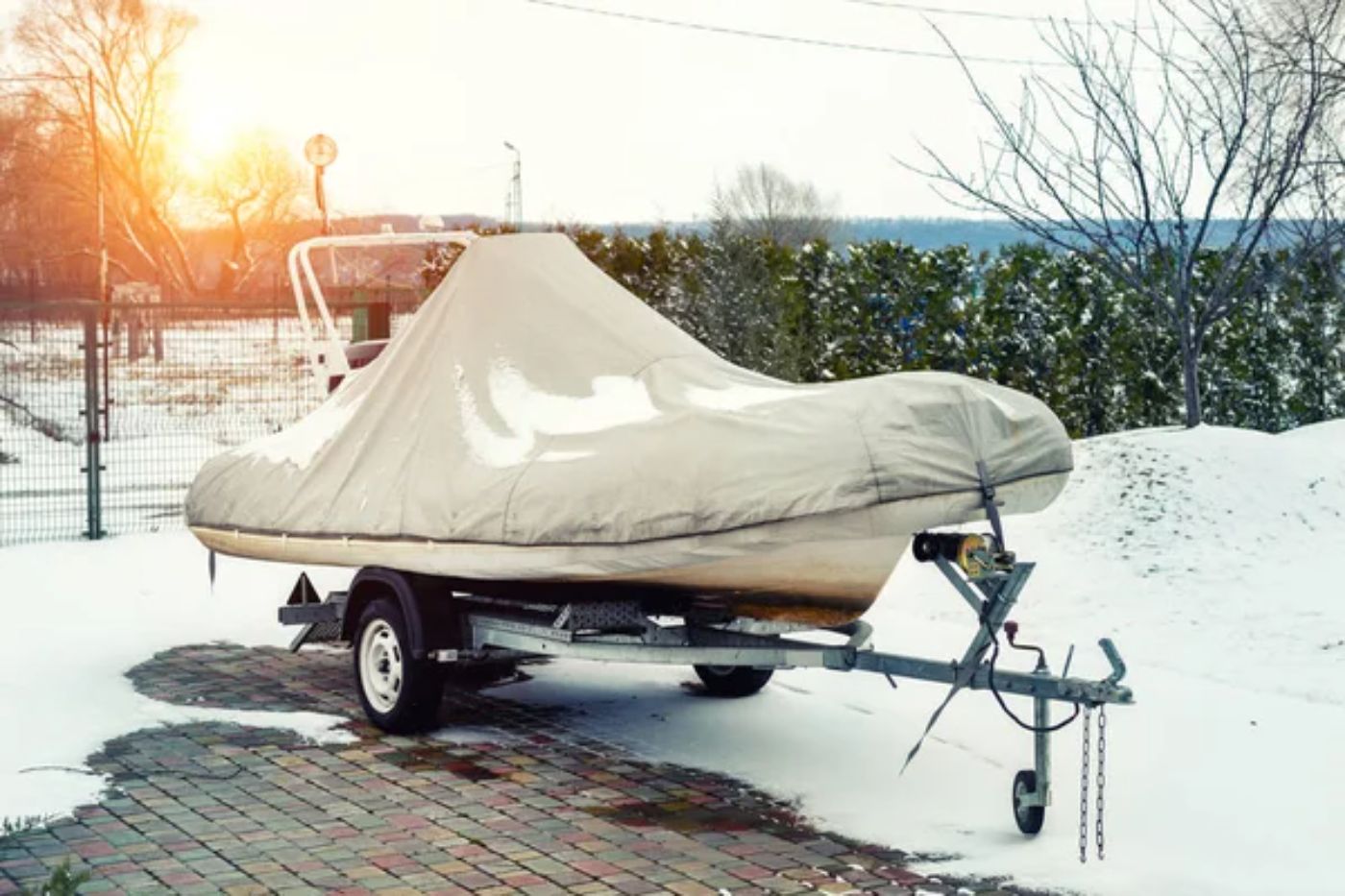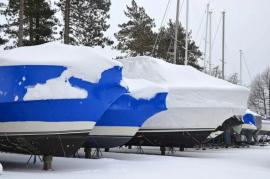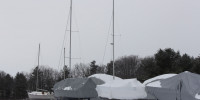How to Cover Your Boat for Winter: 7 Hacks to Not Mess Up
Covering your boat can help prevent damage from things like snow, ice, and freezing temperatures. However, covering your boat is not as simple as throwing a tarp over it and calling it a day. In this article, we will share with you seven hacks to help you properly cover your boat for the winter.
A few hacks to help cover your boat properly include choosing the right boat cover, cleaning and winterizing your boat before covering, securing your boat cover, using moisture-absorbing products in your boat, avoiding sharp edges and protrusions, using a boat cover support pole and covering all openings on your boat.
Using moisture-absorbing products in your boat can prevent damage caused by moisture, such as mold, mildew, rust, and corrosion. Some of these products include desiccants and dehumidifiers. Let's take a look at how each of them prevents moisture buildup on your boat during winterization.
Summary
- Securing your boat cover with tie-down straps and bungee cords can help prevent damage from wind and snow.
- Using a boat cover support pole, PVC pipe, or wooden dowels can prevent water from pooling on top of the cover and causing damage.
- To avoid sharp edges and protrusions on your boat, try using padding, a cover support system, a bow sock, or a cover repair kit to protect your boat cover from damage.
- To prevent water from getting inside and causing damage, you will need to cover all openings on your boat, such as the engine, vents, windows, hatches, and ports.

On this page:
- Hack #1: Choose the Right Cover
- Hack #2: Clean and Winterize Boat
- Hack #3: Secure Your Cover
- Hack #4: Use Moisture-Absorbing Products in Your Boat
- Hack #5: Avoid Sharp Edges and Protrusions on Your Boat
- Hack #6: Use a Boat Cover Support Pole
- Hack #7: Cover All Openings
- Putting On a Boat Cover
- Best Way to Cover Boat for Winter
Hack #1: Choose the Right Cover
A properly fitting cover will keep your boat clean and dry, preventing damage from rain, snow, and UV rays.

How To Make an Affordable DIY Winter Boat Cover
Measure your boat before buying a cover
Measuring your boat ensures that you get a cover that fits your boat properly and provides adequate protection.
- Measure the length, width, and height of your boat, and be sure to take into account any accessories or equipment that may be on board.
- Once you have your measurements, you can start looking at different materials and styles of covers.
Tips to choose the right material and style
When choosing the style of cover, perhaps consider whether you want a custom-fit cover or a universal cover. Custom-fit covers are designed specifically for your boat and will provide the best protection, but they can be more expensive.
Universal covers are less expensive and easier to find, but they may not fit your boat as well. Here are some tips on how you can choose the right boat cover:
Consider the climate
If you live in an area with harsh weather conditions, such as extreme heat, cold, or precipitation, you may need a more durable and weather-resistant cover.

Look for breathable materials
A breathable cover will allow air to circulate, preventing moisture buildup and mold growth. This is especially important if you plan to store your boat for long periods of time.

What's the Best Material for Winter Boat Covers?
Choose a cover with reinforced seams
The seams of your cover are vulnerable to wear and tear, so look for a cover with reinforced seams to ensure durability.
Consider the color
Lighter colors reflect sunlight and heat, while darker colors absorb them. If you live in a hot climate, a lighter-colored cover may be a better choice.
Think about the style of your boat
A pontoon boat will require a different style of cover than a fishing boat or a sailboat. Choose a cover that is designed to fit your boat's style and shape.
Look for a warranty
A warranty can give you peace of mind and protect your investment. Look for a cover with a warranty that covers defects and normal wear and tear.
Hack #2: Clean and Winterize Boat

Importance of cleaning and drying before covering
Cleaning and drying your boat before covering it helps to prevent the growth of mold, mildew, and other harmful organisms that can damage your boat's interior and exterior.
It also helps to prevent the accumulation of dirt, debris, and other contaminants that can cause corrosion and other types of damage to your boat's surfaces.
Tips to winterize your boat's system
Here are some tips for winterizing your boat's engine, fuel system, and other components:
Winterizing the engine
- Run the engine for a few minutes to warm it up. This will help to remove any moisture that may have accumulated in the engine oil.
- Once the engine is warm, change the oil and filter. This will help to remove any contaminants that may have accumulated in the oil.
- Add a fuel stabilizer to the fuel system to keep the fuel fresh during winter storage.
Winterizing the fuel system
- Start by filling the fuel tank with fresh fuel. This will help to prevent the buildup of condensation in the tank.
- Add a fuel stabilizer to the fuel system to keep the fuel fresh during winter storage.
- Run the engine for a few minutes to circulate the stabilized fuel throughout the fuel system.
Winterizing other boat components
- To winterize other components of your boat, such as the water system, bilge pump, and electrical system, start by draining all water from the system. This will help to prevent the buildup of ice that can damage the system.
- Add antifreeze to the system to prevent any remaining water from freezing.
- Disconnect the battery and store it in a cool, dry place.
If you need a step-by-step guide on how to winterize a sailboat, here's an article you might find helpful.
Hack #3: Secure Your Cover
Wind and snow can cause significant damage to your cover and the items it is meant to protect. Therefore, you might need to take measures to secure your cover and prevent it from being blown away or damaged. Some of these measures include the following:
Use tie-down straps
Tie-down straps are designed to hold your cover in place and prevent it from being lifted by strong winds. When using tie-down straps, you need to check if they are tight enough to keep the cover in place but not so tight that they damage the cover or the items underneath.

Use bungee cords
Bungee cords are elastic and can be stretched to fit over the cover and hold it in place. Ensure that they are not too tight as they can damage the cover or the items underneath.
Other methods for securing your cover include using sandbags or weights to hold it in place. These methods are especially useful for covers that are placed on uneven surfaces or in areas with high winds.
Hack #4: Use Moisture-Absorbing Products in Your Boat
During winter storage, moisture can cause significant damage to your boat. It can lead to the growth of mold and mildew, which can cause unpleasant odors and health problems. Moisture can also cause rust and corrosion on metal parts, damage to electrical systems, and rotting of wood.
To prevent this damage, it is essential to use moisture-absorbing products in your boat such as the following:
Try using desiccants
Desiccants are materials that absorb moisture from the air. They are often made of silica gel, which is a porous material that can hold a large amount of water.
Desiccants come in various forms, such as packets, bags, or canisters. You can place them in different areas of your boat, such as the cabin, storage compartments, and engine room. Make sure to follow the manufacturer's instructions for the recommended amount and placement of the desiccant.
Use dehumidifiers
There are two types of dehumidifiers: electric and non-electric. Electric dehumidifiers use a fan and compressor to remove moisture from the air. They are more expensive but are more effective in reducing humidity levels.
Non-electric dehumidifiers, such as moisture traps or buckets, work by absorbing moisture from the air and collecting it in a container. They are less expensive but require regular emptying.
Other products that can help reduce moisture buildup in your boat include ventilation systems, air dryers, and moisture meters:
- Ventilation systems can help circulate air and reduce humidity levels. Air dryers use heat to remove moisture from the air.
- Moisture meters can help you monitor the humidity levels in your boat and determine if additional measures are necessary.
Hack #5: Avoid Sharp Edges and Protrusions on Your Boat
Cover damage can occur due to various reasons, such as sharp edges or protrusions on your boat. In this section, we will discuss common causes of cover damage and provide tips for using padding or other methods to protect your cover from damage.
Common causes of cover damage
- Sharp edges: Sharp edges on your boat can cut through the cover material and cause damage. These edges can be found on various parts of your boat, such as the windshield, cleats, and rails.
- Protrusions: Protrusions on your boat, such as antennas or fishing rods, can poke through the cover and cause damage.
- Wind: Strong winds can cause the cover to flap against sharp edges or protrusions, causing damage.
Tips to protect your boat cover
Use padding
You can use foam padding or old towels to cover sharp edges and protrusions. This will prevent the cover from coming into direct contact with these areas and reduce the risk of damage.
Use a cover support system
A cover support system can help prevent damage caused by wind. It will keep the cover taut and prevent it from flapping against sharp edges or protrusions.
Use a bow sock
A bow sock is a padded cover that fits over the bow of your boat. It will protect the cover from damage caused by the windshield, cleats, and other sharp edges.
Use a cover repair kit
If your cover does get damaged, you might want to repair it as soon as possible. A cover repair kit will allow you to patch small holes or tears in the cover before they become larger.
Hack #6: Use a Boat Cover Support Pole
When a boat cover is not supported properly, it can sag in the middle, which can cause water to pool on top of the cover. This can lead to damage to the boat and the cover, as well as mold and mildew growth.

3 Cheap Ways to Make a DIY Frame for Your Boat Winter Cover
Here are some examples of how to use support poles to create a peak in the center of the cover:
Adjustable support poles can create a peak in the center of a boat cover
These poles can be adjusted to the desired height and can be used on boats of different sizes. They are typically made of aluminum or fiberglass and are lightweight and easy to install.
PVC pipe can be another option
To create one, cut the PVC pipe to the desired length and place one end on the boat’s frame and the other end on the cover. Secure the pipe in place with duct tape or bungee cords.
You can use wooden dowels too
Wooden dowels can also be used to create a peak in the center of a boat cover. Cut the dowels to the desired length and place them on the boat’s frame. Then, drape the cover over the dowels and secure it in place with tie-down straps.
Hack #7: Cover All Openings
This hack makes sure that all openings on the boat are covered to prevent water from getting inside the boat and causing damage.
Boat openings that should be covered
Here are some examples of the types of openings that should be covered:
-
Engine: Make sure the engine is covered with a waterproof cover to prevent water from getting inside and causing damage.
-
Vents: Vents are a part of a boat's ventilation system, but they can also allow water to get inside the boat. Make sure all vents are covered with a vent cover to prevent water from getting inside.
-
Windows: Keep all windows closed and covered with a window cover to prevent water from getting inside.
-
Hatches: Hatches are openings on the deck or cabin of a boat that provides access to the inside of the boat. They are typically designed to be watertight, but they can still allow water to seep in if they are not properly covered. To prevent water from getting inside the boat through the hatches, make sure that all hatches are closed and securely fastened.
-
Ports: Ports are typically located on the sides of the boat and provide light and ventilation to the interior. To prevent water from getting inside, it is recommended to cover the ports with a port cover.
Putting On a Boat Cover
Putting on a boat cover can be a bit tricky, but with a little practice and patience, it can be done easily. Here are some steps you can follow to put on a boat cover:
Clean the boat
Before putting on the cover, make sure that your boat is clean and dry. This will help prevent dirt and debris from getting trapped under the cover and causing damage to your boat.
Unfold the cover
Carefully unfold the cover and lay it out on a clean, flat surface. Make sure that the cover is facing the right way up and that any zippers or other openings are in the right position.
Position the cover
Position the cover over the boat, making sure that it is centered and that it covers the entire boat. If you have a helper, you can ask them to hold one end of the cover while you position the other end.
Secure the cover
Once the cover is in position, start securing it to the boat. Begin by securing the cover around the bow and stern of the boat, using any straps or ropes that are provided with the cover. Then, work your way around the sides of the boat, securing the cover in place as you go.
Adjust the cover
Once the cover is in place, make any necessary adjustments to ensure that it is snug and secure. You may need to tighten straps or ropes or adjust the position of the cover slightly to ensure that it fits properly.
Check for gaps
Finally, check the cover for any gaps or areas where it is not fitting properly. If you find any gaps, try to adjust the cover or add extra straps or ropes to ensure that it is secure and snug.
Best Way to Cover Boat for Winter
Step-by-step guide on how to properly cover your boat
Create a support system
Use PVC pipes and fittings to create a frame over your boat. This frame should create a peak in the middle of the boat to prevent water and snow from collecting on the cover.
Cover the boat with a tarp
Once the frame is in place, cover the boat with a tarp. Make sure the tarp is large enough to cover the entire boat and reach the ground on all sides.
Secure the tarp to the frame
Use bungee cords to secure the tarp to the frame. See if the tarp is tight and secure, without any low spots where water or snow can collect.
Add vents to the cover
To ensure proper ventilation, add vents to the tarp. These vents can be purchased or made by cutting small holes in the tarp and covering them with mesh.
Apply shrink wrap
Once the tarp is in place, apply shrink wrap over the top of the tarp. Make sure the shrink wrap is large enough to cover the entire boat and reach the ground on all sides.
Shrink the wrap
Use a heat gun to shrink the wrap to fit tightly over the boat. Start at the top of the boat and work your way down, making sure to apply heat evenly and avoid using too much heat in one area.
Pad sharp points or edges
Before applying the shrink wrap, see to it that you have padded any sharp points or edges on the boat to prevent them from puncturing the shrink wrap.
How to cover a sailboat for winter
Covering a sailboat for winter may differ from covering other types of boats like motorboats or fishing boats. Sailboats typically have a different shape and structure than motorboats, which can affect the way they are covered for winter.
Sailboats may have a taller mast or rigging that needs to be taken into account when covering the boat. The cover may need to be designed to accommodate these features and provide enough clearance to avoid damage.
Additionally, they may have more delicate equipment such as sails, lines, and electronics that need to be removed and stored separately to prevent damage during the winter.
This can be a more time-consuming process than covering a motorboat, which may only require removing the engine and other mechanical parts.
Best way to tarp a boat for winter

Tarping boat for winter storage
The best way to tarp a boat for winter depends on several factors, including the size and shape of your boat, the climate in your area, and the type of tarp you use.
If you have a small boat, a single tarp may be sufficient to cover the entire boat. However, if you have a larger boat, you may need to use multiple tarps to cover the entire vessel adequately.
If you live in an area with heavy snowfall, you may need to use a tarp with a steeper pitch to prevent snow from accumulating on top of the tarp.
Additionally, you may need to use additional supports, such as poles or ropes, to prevent the tarp from collapsing under the weight of the snow. You should also use a tarp that is specifically designed for outdoor use and can withstand the harsh winter elements.
Perhaps you might want to consider using a tarp with UV protection to prevent the sun's rays from damaging the boat's paint or upholstery.
See more of the benefits and drawbacks of using a tarp as a boat cover in this article.
Did you find the answer to your specific question?
👍 0 👎 1




Leave a comment